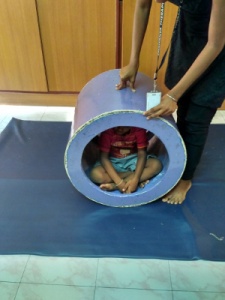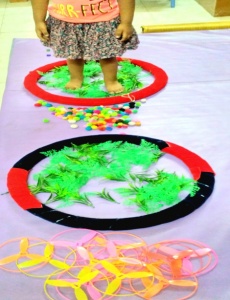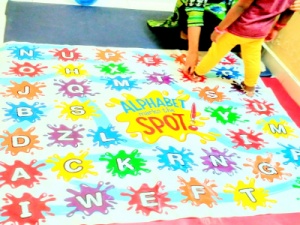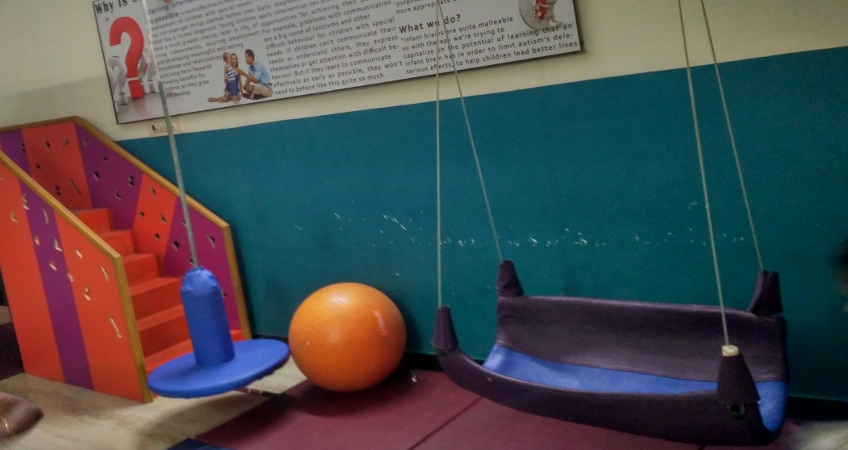Sensory Integration Therapy (SI)
Sensory Processing Disorder:
Sensory processing is an internal process of the nervous system which helps us receive, organize and understand sensory information from both the environment (auditory and visual input as well as taste and smell) and from within our bodies (touch, movement and joint Receptors).To put in simple words: to identify a toy car: the color, size, function etc. are needed to be recognized. Efficient sensory processing enables us to participate fully in everyday activities and respond to environmental demands and adequately engage in our daily routines and roles.
There are a lot of variations when it comes to sensory processing one being more attracted to things and the second being exactly opposite –avoiding any object, third being sensitive where they are not totally inclined but can accept a little ( for example: it’s okay if there is sound but when it is intense, the child cannot handle).
That is:
Sensory seeking, e.g. may be on the move touching everything
Sensory avoiding, e.g. may seem withdrawn, reluctant to move, climb, etc., avoid touching things, getting messy, etc.
Sensory sensitivity, e.g. oversensitive to sound and/or touch, and easily irritated

Vestibular processing skill (Balance)
Therefore, to bring a child to balance on its own requires bringing in awareness of the body. A child might walk comfortably in the ground but when he/she has to stand on a stair/ play a see-saw in the park then they will very afraid and would try to avoid that situation.
Inadequate sensory processing of vestibular input
A disturbance in the sensory processing leads to hindrances in performing the functions efficiently. There are certain clues through which the inadequacy can be identified. We need to understand that they are two different sets in every input avoiding and seeking.
How do we identify:
First, let’s look at -Sensory avoiding:
Child avoids activities that include strong movement experiences. Such as hanging upside down on a monkey bar, lying back on a piece of equipment that rocks or it is otherwise unstable. A child who needs to hop, step on a swing to sit on it will clearly avoid it.
Next, Sensory seeking:
A child continues to seek the activities which involve extra movement (for example; a child might prefer to sit on a swing rather than a chair) as an effort to “fuel” their brain with meaningful information.
 Touch processing skill:
Touch processing skill:
- Touch as the name suggests it is related to feeling something with the help of the body.
- Inadequate sensory processing of touch input can be identified through certain actions such as:
- A child might put things in mouth, chew sleeves/ pencils or bite self
- Seek out messy play/activities/textures
- Unaware of food/paint on hands/ face
- Have difficulty to keep the place clean and tidy
- The child will not notice if clothing is crumpled or inside out
- Show a preference for tight clothing and items that are too small
- Lack of awareness of injury - may not notice cuts/bruises
- Be unaware of touch from others or objects unless intense, frequently hurt other children when playing, e.g. can stand on someone’s foot without noticing
When the child is seeking touch:
- Prefer intense flavours and textures of food, e.g. spicy, sweet, and sour
- Have limited awareness of personal space of self and that of others—tend to invade the personal space of others
- Sit too close to other children during playtime
Auditory Processing:
Auditory processing is an important foundation for the development of language skills and plays an important role in classroom performance and peer relationships.
 How it can be identified?
How it can be identified?
- Appear confused or inattentive.
- Randomly rush into tasks
- May take a long time to respond to directions and to complete tasks.
- Over respond to competing for noise in the environment
- Difficulty in following several instructions or will require extra effort.
- Find it hard to focus on work when there is a lot of noise
- Dislike noisy places such as a park or theatre
- Be distractible and have poor concentration
- Cover their ears or scream at certain noises
- Not respond to voices, even in a quiet environment
- Appear not to hear
- Appear oblivious to what is going on around them
- Need instructions to be repeated
- Love excessively loud noises
Proprioceptive processing issues:
In simple terms, Proprioception helps us move.
How it can be identified?
- Body movements would be slower, clumsier, and involve more effort.
- Difficult to button clothes, screw a lid on a jar, or remember which way to turn a bottle knob
- Difficulty in walking downstairs
- Difficulty in doing any task when they cannot see it with their eyes.
- Be constantly ‘on the go’ and fidgeting, rock on a chair and balance on two legs of the chair
- Have low muscle tone
- Become easily frustrated
- Seek out physical contact/ hugs
- Press too hard or too lightly with a pencil when writing
- Drop things or overshoot when pouring
- Use too much or too little force with actions
- Bump into others/furniture/doorframes, etc.,
Sensory Integration Therapy/Treatment Intervention
How does Therapy help?
- Therapy strategies to improve tactile discrimination: less challenging textures and building from this to allow the child to control the level of contact and stop when she needs to. For children who are less aware of touch and maybe touch seeking, there is a need to help develop discriminative ability.
- Encourage the child to explore different textures on his skin, e.g. paint brushes, liquid soap.
- Dress up in different clothing, e.g. silk, fur.
- Play with different textured objects and ask the child to identify different features, e.g. hard/soft
- Feely box—hide objects in rice/sand/ and ask the child to find them.
Therapy strategies for sensation avoiding
- Prepare the child in advance of changes in position; break down the task into achievable steps.
- Grade the activity to build up the child’s tolerance of movement gradually.
- Allow the children to lead the activity at their own pace to prevent adverse reactions.
Therapy strategies for sensation seeking
- Incorporate movement activities into the child’s daily life, e.g. trampoline jumping, running.
- Give the child regular movement breaks throughout the day.
- Allow the child to regularly change position (floor sitting, sitting on a chair, standing, lying on the floor, kneeling)
- Activities that require rapid anticipation of movement also help to teach motor planning
- Start with slow, rhythmic movements and gradually increase the speed and postural demands.
- Jump over Trampoline
- Swing Play
- Slide play
- Balance board activities

